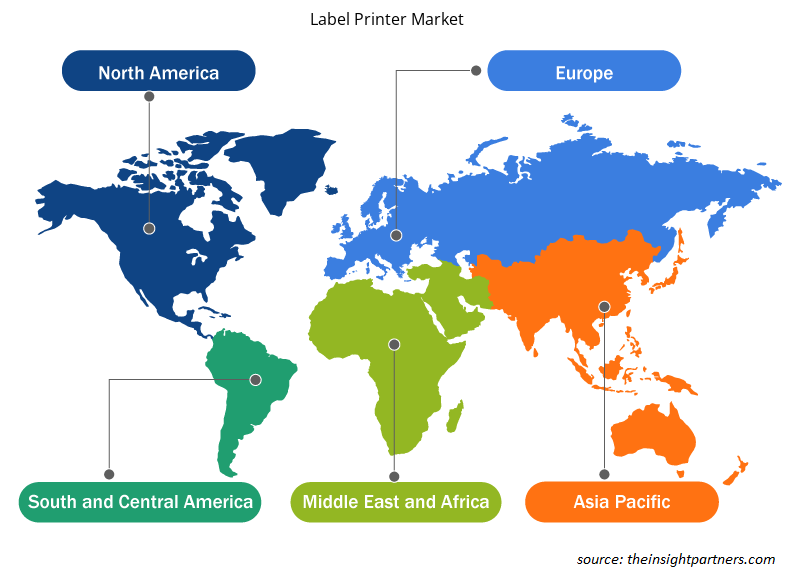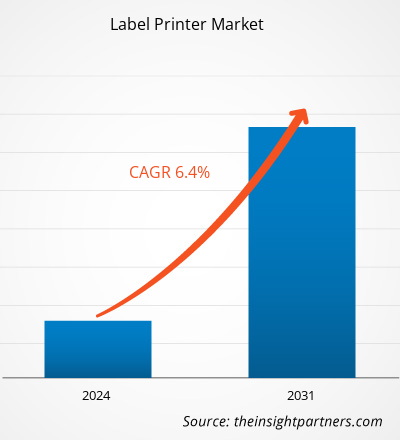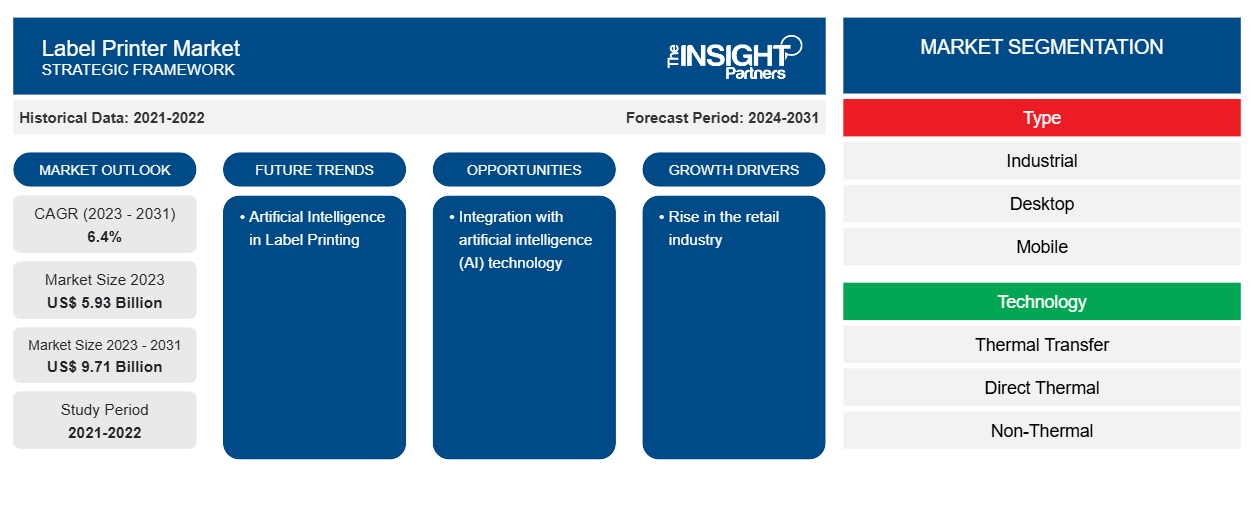Der Markt für Etikettendrucker soll von 5,93 Milliarden US-Dollar im Jahr 2023 auf 9,71 Milliarden US-Dollar im Jahr 2031 anwachsen. Der Markt wird voraussichtlich zwischen 2023 und 2031 eine durchschnittliche jährliche Wachstumsrate (CAGR) von 6,4 % verzeichnen. Die steigende Nachfrage nach Etikettendruckern aus dem Pharmasektor und das Wachstum in der Verpackungsindustrie dürften weiterhin die wichtigsten Trends auf dem Etikettendruckermarkt bleiben.
Etikettendrucker Marktanalyse
Zahlreiche Branchen, darunter Lieferkettenmanagement, Preisauszeichnung im Einzelhandel, Verpackungsetiketten und andere, verwenden Etikettendrucker. Die Informationen oder Symbole über das Produkt oder den Artikel, die sowohl für den Verkäufer als auch für den Kunden hilfreich sind, werden mit Etikettendruckern gedruckt. Die Nachfrage nach Desktop- und mobilen/tragbaren Druckern dürfte im Prognosezeitraum stark ansteigen, da die Fertigungsindustrie weiterhin einfache, praktische Etikettendruckwerkzeuge benötigt. Darüber hinaus fördert das Wachstum im Einzelhandel die Nachfrage nach Etikettendruckern weiter.
Marktübersicht für Etikettendrucker
Ein Etikettendrucker ist ein Computerdrucker, der auf Karton (Etiketten) oder selbstklebendes Etikettenmaterial drucken kann. Etikettendrucker sind Etikettendrucker mit integrierter Tastatur und Anzeige für den Standalone-Betrieb (d. h. ohne Anschluss an einen separaten Computer). Etikettendrucker unterscheiden sich von normalen Druckern, da sie spezielle Zuführmechanismen für die Verarbeitung von Rollenware oder Abreißblättern (Leporello) benötigen. Etikettendrucker verwenden eine Vielzahl von Etikettenmaterialien, z. B. Papier und synthetische Polymermaterialien (Kunststoff).
Passen Sie diesen Bericht Ihren Anforderungen an
Sie erhalten kostenlos individuelle Anpassungen an jedem Bericht, einschließlich Teilen dieses Berichts oder einer Analyse auf Länderebene, eines Excel-Datenpakets sowie tolle Angebote und Rabatte für Start-ups und Universitäten.
-
Holen Sie sich die wichtigsten Markttrends aus diesem Bericht.Dieses KOSTENLOSE Beispiel umfasst eine Datenanalyse von Markttrends bis hin zu Schätzungen und Prognosen.
Treiber und Chancen auf dem Etikettendruckermarkt
Anstieg im Einzelhandel begünstigt Markt
Weltweit steigen das verfügbare Einkommen und die Kaufkraft der Verbraucher, was zum Kauf verschiedener Einzelhandelsprodukte führt. Darüber hinaus führt das Bevölkerungswachstum auch zu einer Nachfrage nach Einzelhandelsprodukten. Das Wachstum im Einzelhandelssektor und in der E-Commerce-Branche erzeugt daher eine Nachfrage nach Geräten und Maschinen wie Etikettendruckern, die die Abläufe in diesen Branchen beschleunigen, um die Nachfrage der Kunden rechtzeitig zu erfüllen. Drucker wie Preisetikettendrucker und Barcodedrucker garantieren, dass Waren angemessen verfolgt, bepreist und den Verbrauchern angezeigt werden. Da die Informationen auf dem Etikett Einzelhändlern helfen, ihren Bestand zu verwalten und Produkte effizient zu lagern, nimmt die Nachfrage nach Etikettendruckern im Einzelhandel zu.barcode printers, guarantee that goods are appropriately tracked, priced, and displayed to consumers. As the information on the label helps retailers manage their inventory and store products efficiently, the demand for label printers is gaining traction in the retail industry.
Künstliche Intelligenz im Etikettendruck – eine Chance auf dem Etikettendruckermarkt
Heutzutage, da sich die digitale Landschaft ständig verändert, suchen Unternehmen aller Branchen immer nach neuen und kreativen Möglichkeiten, ihre Abläufe zu verbessern und sich einen Wettbewerbsvorteil zu verschaffen. Der Etikettendruck ist nur einer der vielen Bereiche des Geschäftsbetriebs, die künstliche Intelligenz (KI) vollständig verändern kann. Unternehmen können KI verwenden, um den Designprozess zu automatisieren und mithilfe ausgefeilter Algorithmen schöne Etiketten zu erstellen. Große Datenmengen wie Designelemente, Branchentrends und Verbraucherpräferenzen können von KI-Algorithmen analysiert werden, um maßgeschneiderte Etikettendesigns für bestimmte Marken oder Produkte zu erstellen. Unternehmen können durch die Implementierung KI-gestützter Qualitätskontrollsysteme garantieren, dass ihre Etiketten den höchsten Standards in Bezug auf Genauigkeit und Ästhetik entsprechen. Dieser Faktor wird letztendlich die Kundenzufriedenheit und den Ruf der Marke verbessern. Solche Vorteile der KI im Etikettendruck werden die Nachfrage nach fortschrittlichen Druckern steigern und lukrative Wachstumschancen für den Etikettendruckermarkt schaffen.
Segmentierungsanalyse des Etikettendrucker-Marktberichts
Wichtige Segmente, die zur Ableitung der Marktanalyse für Etikettendrucker beigetragen haben, sind Typ, Technologie und Endbenutzerbranche.
- Je nach Typ ist der Markt in Industrie, Desktop und Mobil segmentiert. Das Desktop-Segment hatte im Jahr 2023 einen größeren Marktanteil.
- Nach Technologie ist der Markt in Thermotransfer , Thermodirekt und Nichtthermisch unterteilt. Das Segment Thermodirekt hatte im Jahr 2023 den größten Marktanteil.
- Basierend auf der Endverbrauchsbranche ist der Markt in Fertigung, Einzelhandel, Transport und Logistik, Gesundheitswesen, FMCG, Unterhaltung und andere segmentiert. Das Einzelhandelssegment hielt im Jahr 2023 einen größeren Marktanteil.
Marktanteilsanalyse für Etikettendrucker nach geografischer Lage
Der geografische Umfang des Marktberichts für Etikettendrucker ist hauptsächlich in fünf Regionen unterteilt: Nordamerika, Asien-Pazifik, Europa, Naher Osten und Afrika sowie Südamerika/Süd- und Mittelamerika.
In Bezug auf den Umsatz hatte Nordamerika den größten Marktanteil bei Etikettendruckern. Die USA, Kanada und Mexiko gehören zu den wichtigsten Ländern Nordamerikas. Die steigende Nachfrage nach Etikettendruckern aus den Endverbraucherbranchen wie Fertigung, Einzelhandel, Logistik und anderen treibt das Marktwachstum in der Region an. Das Bevölkerungswachstum in der Region erzeugt außerdem die Nachfrage nach verschiedenen Produkten und Dienstleistungen, die Etiketten mit allen produktbezogenen Informationen erfordern, was die Nachfrage nach Etikettendruckern weiter ankurbelt.
Regionale Einblicke in den Etikettendruckermarkt
Die regionalen Trends und Faktoren, die den Etikettendruckermarkt während des Prognosezeitraums beeinflussen, wurden von den Analysten von Insight Partners ausführlich erläutert. In diesem Abschnitt werden auch die Marktsegmente und die Geografie des Etikettendruckermarkts in Nordamerika, Europa, im asiatisch-pazifischen Raum, im Nahen Osten und Afrika sowie in Süd- und Mittelamerika erörtert.

- Erhalten Sie regionale Daten zum Etikettendruckermarkt
Umfang des Marktberichts für Etikettendrucker
| Berichtsattribut | Details |
|---|---|
| Marktgröße im Jahr 2023 | 5,93 Milliarden US-Dollar |
| Marktgröße bis 2031 | 9,71 Milliarden US-Dollar |
| Globale CAGR (2023 - 2031) | 6,4 % |
| Historische Daten | 2021-2022 |
| Prognosezeitraum | 2024–2031 |
| Abgedeckte Segmente |
Nach Typ
|
| Abgedeckte Regionen und Länder |
Nordamerika
|
| Marktführer und wichtige Unternehmensprofile |
|
Dichte der Marktteilnehmer für Etikettendrucker: Deren Auswirkungen auf die Geschäftsdynamik
Der Markt für Etikettendrucker wächst rasant. Dies wird durch die steigende Nachfrage der Endnutzer aufgrund von Faktoren wie sich entwickelnden Verbraucherpräferenzen, technologischen Fortschritten und einem größeren Bewusstsein für die Vorteile des Produkts vorangetrieben. Mit der steigenden Nachfrage erweitern Unternehmen ihr Angebot, entwickeln Innovationen, um die Bedürfnisse der Verbraucher zu erfüllen, und nutzen neue Trends, was das Marktwachstum weiter ankurbelt.
Die Marktteilnehmerdichte bezieht sich auf die Verteilung der Firmen oder Unternehmen, die in einem bestimmten Markt oder einer bestimmten Branche tätig sind. Sie gibt an, wie viele Wettbewerber (Marktteilnehmer) in einem bestimmten Marktraum im Verhältnis zu seiner Größe oder seinem gesamten Marktwert präsent sind.
Die wichtigsten auf dem Etikettendruckermarkt tätigen Unternehmen sind:
- Toshiba Tec Corporation
- Honeywell International Inc.
- Postek Electronics Co., Ltd.
- Wasp Barcode-Technologien
- VIPColor Technologies Pte Ltd.
- GoDEX International Co., Ltd.
Haftungsausschluss : Die oben aufgeführten Unternehmen sind nicht in einer bestimmten Reihenfolge aufgeführt.

- Überblick über die wichtigsten Akteure auf dem Etikettendruckermarkt
Neuigkeiten und aktuelle Entwicklungen auf dem Etikettendruckermarkt
Der Etikettendruckermarkt wird durch die Erfassung qualitativer und quantitativer Daten nach Primär- und Sekundärforschung bewertet, die wichtige Unternehmensveröffentlichungen, Verbandsdaten und Datenbanken umfasst. Im Folgenden finden Sie eine Liste der Entwicklungen auf dem Markt:
- Im Februar 2023 kündigte Epson seine ersten Etikettendrucker speziell für Bastler und den Heimgebrauch an. Die LabelWorks LW-C610 und LW-C410 sind leicht, tragbar und einfach von einem Mobilgerät aus zu bedienen, was sie ideal zum Aufräumen, Organisieren und Basteln im gesamten Haus und Büro macht. (Quelle: Epson, Pressemitteilung, 2023)
- Im Mai 2023 kündigte Newland AIDC, ein führendes Unternehmen in der Branche der automatischen Identifikation und Datenerfassung, die Markteinführung seines ersten Etikettendruckers, des NLS-LP410, an. Der neue Thermotransfer-Etikettendrucker ist die neueste Ergänzung der überlegenen umfassenden Produktlinie des Unternehmens, die Barcode-Lesegeräte, mobile Terminals, interaktive Kioske und OEM-Scan-Engines umfasst. (Quelle: Newland AIDC, Pressemitteilung, 2023)
- Im April 2023 kündigte SATO, ein weltweit führender Anbieter von Barcodedruck-, Etikettier- und Auto-ID-Lösungen, die Markteinführung des CT4-LX-HC an, eines speziellen intelligenten und intuitiven 4-Zoll-Etikettendruckers für den Gesundheitssektor. Der CT4-LX-HC ist ein außergewöhnlich vielseitiger Desktop-Drucker, der für eine Patienten- und Verbraucherversorgung auf höchstem Niveau konzipiert ist. Er verfügt außerdem über ein antimikrobielles Gehäuse, das mit Desinfektionstüchern abgewischt werden kann, um das Risiko von Infektionen und Rekontaminationen in einer klinischen Umgebung zu minimieren. (Quelle: SATO, Pressemitteilung, 2023)
Marktbericht zu Etikettendruckern – Umfang und Ergebnisse
Der Bericht „Marktgröße und Prognose für Etikettendrucker (2021–2031)“ bietet eine detaillierte Analyse des Marktes, die die folgenden Bereiche abdeckt:
- Marktgröße und Prognose auf globaler, regionaler und Länderebene für alle wichtigen Marktsegmente, die im Rahmen des Projekts abgedeckt sind
- Marktdynamik wie Treiber, Beschränkungen und wichtige Chancen
- Wichtige Zukunftstrends
- Detaillierte PEST/Porters Five Forces- und SWOT-Analyse
- Globale und regionale Marktanalyse mit wichtigen Markttrends, wichtigen Akteuren, Vorschriften und aktuellen Marktentwicklungen
- Branchenlandschaft und Wettbewerbsanalyse, einschließlich Marktkonzentration, Heatmap-Analyse, prominenten Akteuren und aktuellen Entwicklungen
- Detaillierte Firmenprofile
- Historische Analyse (2 Jahre), Basisjahr, Prognose (7 Jahre) mit CAGR
- PEST- und SWOT-Analyse
- Marktgröße Wert/Volumen – Global, Regional, Land
- Branchen- und Wettbewerbslandschaft
- Excel-Datensatz
Aktuelle Berichte
Verwandte Berichte
Erfahrungsberichte
Grund zum Kauf
- Fundierte Entscheidungsfindung
- Marktdynamik verstehen
- Wettbewerbsanalyse
- Kundeneinblicke
- Marktprognosen
- Risikominimierung
- Strategische Planung
- Investitionsbegründung
- Identifizierung neuer Märkte
- Verbesserung von Marketingstrategien
- Steigerung der Betriebseffizienz
- Anpassung an regulatorische Trends























 Kostenlose Probe anfordern für - Etikettendruckermarkt
Kostenlose Probe anfordern für - Etikettendruckermarkt